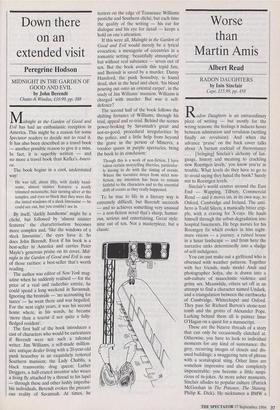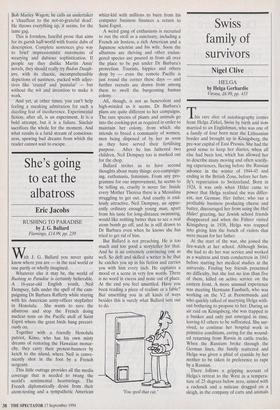Worse than Martin Amis
Albert Read
RADON DAUGHTERS by lain Sinclair Cape, £15.99, pp. 458 Radon Daughters is an extraordinary piece of writing — but mostly for the wrong reasons: the feelings it induces hover between admiration and revulsion (settling finally on revulsion). And when the advance 'praise' on the back cover talks about 'A barium cocktail of fluoromancy . . . [ bringing] Sinclair's alchemy of lan- guage, history and meaning to crackling new Roentgen levels,' you know you're in trouble. What levels do they have to go to to avoid saying they hated the book? Surely not to Roentgen levels.
Sinclair's world centres around the East End — Wapping, Tilbury, Commercial Road — and it moves on, in its own way, to Oxford, Cambridge and Ireland. The anti- hero is Todd Sileen, a manically bitter crip- ple, with a craving for X-rays. He hauls himself through the urban degradation into hospital basements. He begs nurses for his Roentgen fix which evokes in him night- mare visions — a journey, a ruined house in a lunar landscape — and from here the narrative sinks determinedly into a sludge of self-indulgence.
You can just make out a girlfriend who is obsessed with weather patterns. Together with her friends, nude model Andi and photographer Sofya, she is drawn into a sub-culture of masochistic violence and grimy sex, Meanwhile, others set off in an attempt to find a character named Undark, and a triangulation between the earthworks of Cambridge, Whitechapel and Oxford. They pass Sir Richard Burton's stone-tent tomb and the grotto of Alexander Pope. Lurking behind them all is painter Imar O'Hagan on a quest for a manuscript.
These are the bizarre threads of a story that can only be occasionally clutched at. Otherwise, you have to look to individual moments for any kind of sustenance: the grey, recurring images of clouds and dis- used buildings; a swaggering turn of phrase with a scatalogical sting. Other lines are somehow impressive and also completely impenetrable: you become a little suspi- cious of in-jokes. At more sober moments, Sinclair alludes to popular culture (Patrick McGoohan in The Prisoner, The Shining, Philip K. Dick). He nicknames a BMW a
Bob Marley Wagon; he calls an undertaker a 'chauffeur to the not-so-grateful dead'. He throws everything up, it seems, for the lame gag.
This is formless, fanciful prose that aims for its garish half-world with frantic dabs of description. Complete sentences give way to brief impressionistic statements of wearying and dubious sophistication. If people say they dislike Martin Amis' novels, they should really try Radon Daugh- ters, with its chaotic, incomprehensible depictions of nastiness, packed with adjec- tives like 'crazed' and 'pustular' — but without the wit and invention to make it work.
And yet, at other times, you can't help feeling a sneaking admiration for such a dazzling feat of incoherence. Experimental fiction, after all, is an experiment. It is a bold attempt, but it is a failure. Sinclair sacrifices the whole for the moment. And what results is a lurid stream of conscious- ness, spewing bad dreams from which the reader cannot wait to escape.



























































 Previous page
Previous page